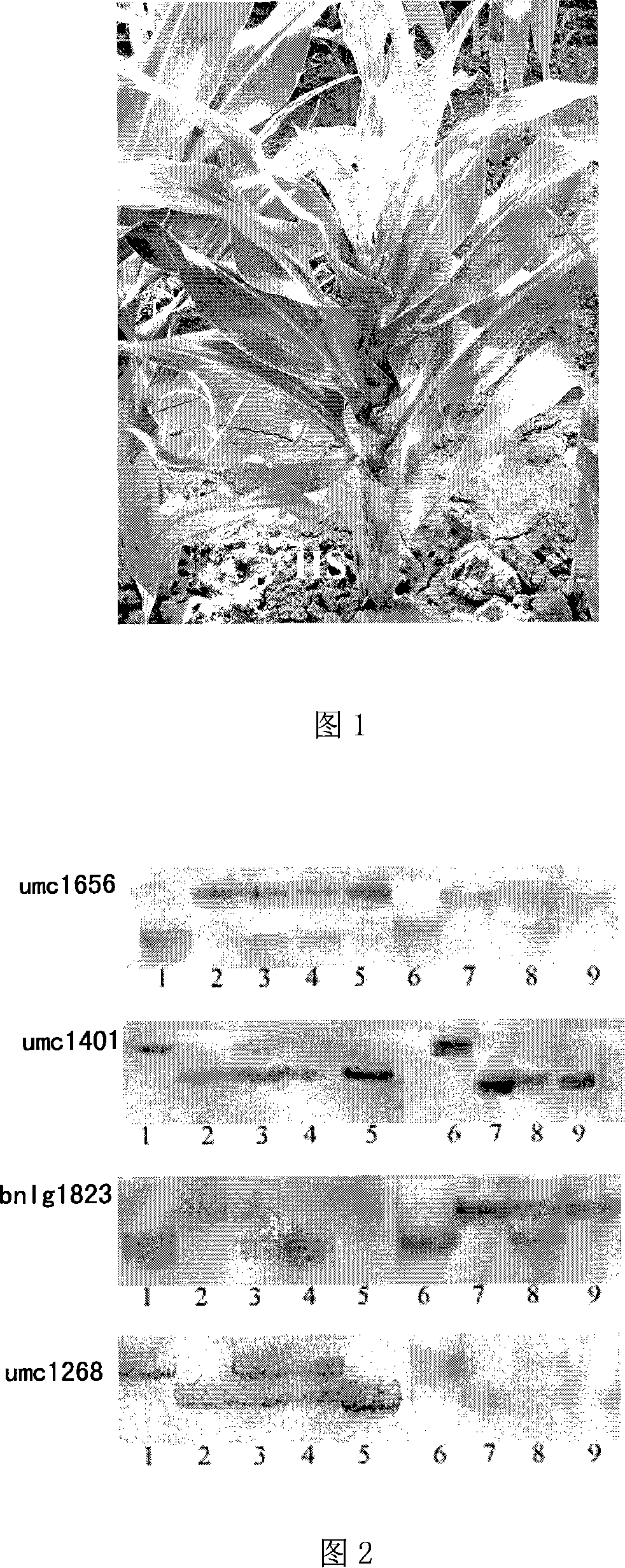Maize inbred line resistant to MRDV bred by using molecule making
A molecular marker and inbred line technology, which is applied in the field of maize breeding and plant bioengineering, can solve the problems of difficult disease resistance identification, time-consuming, labor-intensive and effective results of inbred lines and hybrids resistant to rough dwarf disease, and different positioning results.
- Summary
- Abstract
- Description
- Claims
- Application Information
AI Technical Summary
Problems solved by technology
Method used
Image
Examples
example 1
[0068] Example 1: Breeding Ye 478 excellent improved line resistant to corn rough dwarf disease
[0069] Using Ye 478 or its improved line as the recipient and recurrent parent, and the inbred line 90110 as the donor of the disease resistance gene locus, excellent improved lines were obtained mainly through the prospect selection of the target gene.
[0070] Procedure one:
[0071] 1) Crossbreed with Ye 478 as the female parent and 90110 as the male parent to produce F 1 plants. This step can be completed in the greenhouse or in Hainan from January to April of the first year.
[0072] 2)F 1 Plant selfing produces F 2 seed. This step is completed in northern my country from May to August of the first year.
[0073] 3) F2 seeds were sown in flower pots, leaf DNA was extracted at the 3-leaf stage of the plants, PCR amplification was performed with primers of SSR markers umc1656, bnlg2191, umc1401, umc1666, bnlg1823 and umc1268 respectively, and the reaction products were su...
example 2
[0090] Example 2: Breeding an excellent improved line of Ye 502 resistant to corn rough dwarf disease
[0091] Using Ye 502 or its improved line as the recipient and recurrent parent, and the inbred line 90110 as the donor of the disease resistance gene locus, excellent improved lines were obtained mainly through the prospect selection of the target gene. Because Ye 502 has poor disease resistance, it is the best plan to improve multiple traits.
[0092] Procedure one:
[0093] 1) F was produced by crossing Ye 502 as the female parent and 90110 as the male parent 1 plants. This step can be completed in the greenhouse or in Hainan from January to April of the first year.
[0094] 2)F 1 Plant selfing produces F 2 seed. This step is completed in northern my country from May to August of the first year.
[0095] 3) F2 seeds were sown in flower pots, leaf DNA was extracted at the 3-leaf stage of the plants, PCR amplification was performed with primers of SSR markers umc1656,...
example 3
[0113] Example 3: Breeding excellent inbred lines resistant to maize rough dwarf disease
[0114] With excellent inbred lines DH4866 and Zheng 58 as recipients and recurrent parents, and inbred line 90110 as donor of disease resistance genes, excellent improved lines with different characteristics were obtained mainly through prospect selection of target genes. Proceed as follows:
[0115] 1) Crossbreed DH4866 and Zheng 58 as the father and mother respectively to produce F 1 seed. This step can be completed in the greenhouse or in Hainan from January to April of the first year.
[0116] 2)F 1 Plant selfing produces F 2 generation seed, from F 2 F 3 Substitute seeds are generally controlled at 30 to 40 ears. This step is completed in northern my country and / or Hainan from May to December of the first year.
[0117] 3)F 3 Plant selective selfing produces F 4 Substitute seeds, and harvest 40-60 ears. This step is completed in the greenhouse or in Hainan from January to A...
PUM
| Property | Measurement | Unit |
|---|---|---|
| diameter | aaaaa | aaaaa |
Abstract
Description
Claims
Application Information
 Login to View More
Login to View More - R&D
- Intellectual Property
- Life Sciences
- Materials
- Tech Scout
- Unparalleled Data Quality
- Higher Quality Content
- 60% Fewer Hallucinations
Browse by: Latest US Patents, China's latest patents, Technical Efficacy Thesaurus, Application Domain, Technology Topic, Popular Technical Reports.
© 2025 PatSnap. All rights reserved.Legal|Privacy policy|Modern Slavery Act Transparency Statement|Sitemap|About US| Contact US: help@patsnap.com

